Are you interested in further information about automated, objective and reproducible scratch/dig inspection? Get in touch with our experts!
Sales Team | Tel.: +49 6201 960 90-20↓ Scratch/dig inspection with ARGOS:
objective, reproducible and fast
↓ Applications
↓ The ARGOS family
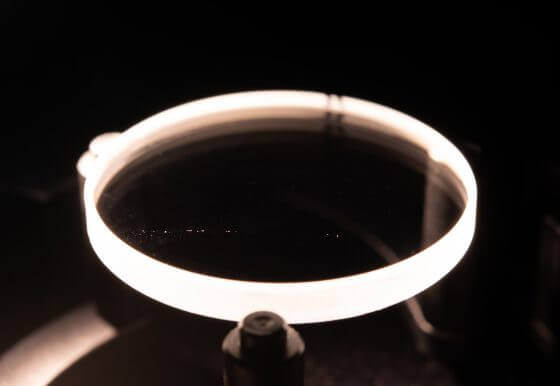
Scratch/dig inspection with ARGOS: objective, reproducible and fast
Until today, the industry standard for surface inspection according to ISO 10110-7 is manual-visual inspection. This is a weak point in the production chain especially for precision optics with high demands on accuracy and documentation. The results are subjective and depend on the daily form of the inspectors. This is exactly where our automated and objective inspection system ARGOS comes in.
↓ Your advantages with automated scratch/dig inspection
↓ Process reliability and process improvement through digitized testing
↓ Intuitive operation – one-click scratch/dig inspection
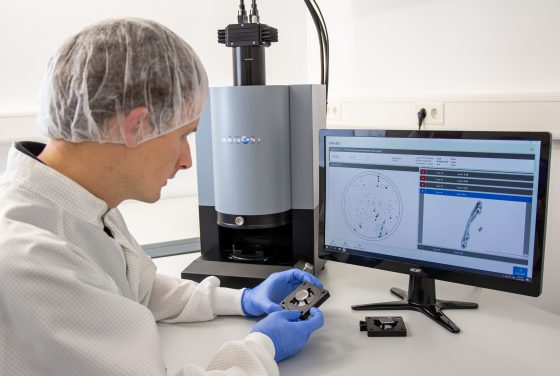
Your advantages with automated scratch/dig inspection
With ARGOS we offer you an operator-independent and automated test according to ISO 10110-7, with objective and reproducible results. Lengthy discussions caused by different estimates of the size of individual defects or time-consuming analyses under the microscope are no longer necessary. Unpleasant disputes with customers or suppliers can be quickly settled to the satisfaction of both parties on the basis of objectively reproducible measurement results.
All results are documented in detailed test reports. Whether in incoming goods inspection or quality assurance, testing with ARGOS gives you process security and allows you to detect errors as early as possible. Due to the good documentation you also have a detailed proof of quality towards your suppliers and customers. More and more companies demand a traceability in the process chain also for optical supplier parts.
By automating your surface scratch/dig inspection, your valuable employees are relieved. With ARGOS you can guarantee the same high quality standards in the long term and reduce your dependence on individual employees with the “golden eye”.
ARGOS works for all practically relevant specifications for the cleanliness of surfaces. Tests are possible up to 5/1×0.016 according to the rules of ISO 10110-7. Even the smallest defects down to 1 µm in size can be reliably detected. From a size of about 2.5 µm, reliable size measurements are possible.
The automation of your surface inspection according to ISO 10110-7 brings many advantages. In addition to the objectivity of the system, the possibilities for further data analysis are also important for many of our customers.

Process reliability and process improvement through digitized inspection
By using ARGOS the inspection process becomes largely independent of subjectivity and human error. ARGOS makes clear and objective pass/fail decisions. For each inspection a detailed inspection report is automatically generated, the results are documented clearly and comprehensibly.
The user-independent and digitized testing provides process reliability through reproducible and objective results. Complaints from customers can be prevented from the outset or rejected as unjustified. The possibility to provide your customer with a documentation of the surface specification test according to ISO 10110-7 creates confidence and underlines your quality standards. Conversely, defective components can be reliably sorted out in the incoming goods inspection by testing with ARGOS and complaints can be lodged with the supplier.
The ARGOS system can be connected directly to your quality assurance system. So a complete assurance and documentation of the process chain is guaranteed. This also creates the necessary data basis for tracing process and product quality with the help of statistical methods. Deviations, e.g. in the coating process, are detected before they become a problem.
By digitizing the surface inspection ARGOS offers analysis possibilities that go beyond the requirements of ISO 10110-7. By evaluating particle densities and histograms, for example, coating processes can be optimized. For this purpose, even large areas up to 200 mm in diameter can be recorded in a few minutes, including counting of all particles and defects.
ARGOS test reports can easily be adapted to customer requirements and are available in different formats. There are clearly arranged PDF reports as well as data formats that are well suited for further data analysis since they are machine readable.
Intuitive handling– one-click scratch/dig inspection
The ARGOS Pro software is intuitively designed and has a clear and simple user interface. The operation of ARGOS can be learned in a few hours and is also possible for users without in-depth knowledge of the system.
Inspection tasks are defined in profiles. These measurement recipes contain all necessary parameters of the part, such as diameter, free aperture or radius of curvature. It is also possible to store your specific parameters such as drawing, part or material numbers. For ARGOS matrix with automation, the positions of the test items in a cassette are also stored in the profile, so that the inspection of all inspected parts in the cassette runs fully automatically without further user input.
The operator then simply selects the appropriate profile and starts the test. Objective surface inspection could not be simpler!
The overall result of the inspection is unambiguous and clearly highlighted on the user interface and in the generated inspection report. In addition, the operator has access to helpful visualizations, for example, to understand why a part failed or to examine the defect development of good parts over several process steps.
Applications
ARGOS systems can be used for many different applications. The testing of optical elements according to ISO 10110-7 is our standard – but by no means the only possibility.
You have an inspection task for a component with polished surfaces? ARGOS is deliberately designed to be open so that it can be easily adapted to customer-specific requirements. No matter if your components are made of glass, plastic, metal or semiconductors – if you want to detect defects or contamination of surfaces, ARGOS is the right choice. Analyses can be carried out according to almost any specifications. Please do not hesitate to get in touch!
↓ Flat optics
↓ Wafers
↓ Spherical and aspherical lenses, cylindrical lenses, volumes
↓ Micro-optics
↓ Assembly of optical components
↓ Fibre ends

Flat optics
ARGOS and ARGOS matrix are ideal for the accurate inspection of plano optics such as mirrors, filters or protective glasses. Especially with hard specifications ARGOS can show its strengths. For example, ARGOS is ideally suited for components of high-power laser systems where even the smallest dust particles can lead to defects.
A sample with a diameter of up to 55 mm can be scanned with ↓ ARGOS 2.1 in only 2 seconds, detecting defects down to 4 µm. Specifications up to 5/1×0.025 can be inspected. Defects of the 3 next smaller steps (i.e. 0.016, 0.01, 0.0063) are taken into account, as required by ISO 10110-7. In addition to locating real defects, the detection of contamination is also reliably possible.
For larger samples ↓ ARGOS 200 offers a maximum test diameter of 200 mm.
For smaller elements ↓ ARGOS matrix is the ideal solution. Here, components with diameters up to about 15 mm are not scanned, but rather taken with a snapshot, which leads to an extremely fast inspection (see also ↓ Micro-optics). This system also allows the automatic inspection of many flat optics in a cassette up to whole production batches at once – without further user interaction. With the “Multi-View Stitching” module, ARGOS matrix also characterizes almost any size of test sample by automatically assembling a large measuring field from many individual measurements.
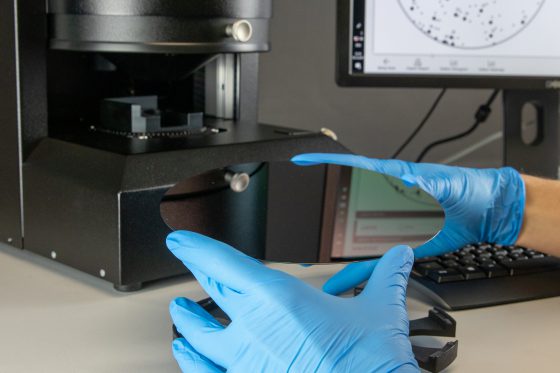
Wafers
Also in the optical industry, components are increasingly produced on wafers and are separated later. With ↓ ARGOS 200 the inspection of glass or silicon wafers up to 200 mm (or 8″) diameter is possible. The entire surface is detected in several automatic ring scans.
There are different possibilities for the analysis:
- Inspection of the entire surface to a specification according to ISO 10110-7
- Statistical analysis of particle or defect size distributions and densities for process analysis
- Evaluation of any number of partial areas of the total area according to ISO 10110-7 and summary of the results in a test report.
Especially when coating thin wafers, the surface often deforms. The actual shape of the surface is measured by ARGOS contactless and precisely. On the one hand, this documents the shape of the surface, on the other hand it ensures that ARGOS is always optimally focused.
For wafer-level optics ↓ ARGOS matrix with automation is the ideal solution. Here, all individual elements on a wafer are characterized fully automatically in individual measurements and as a result, individual test reports are generated for each element as well as a map with marked good and rejected parts.
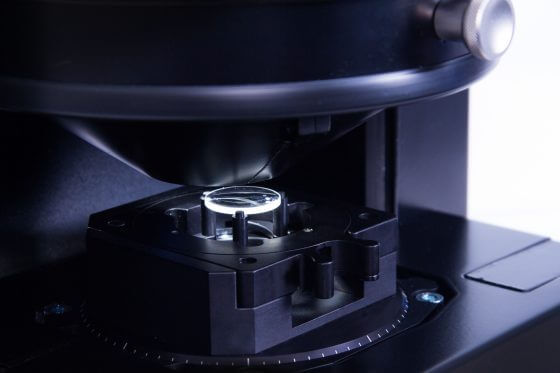
Spherical and aspherical lenses, cylindrical lenses, volumes
All ARGOS systems use automatic focus stacking to inspect curved surfaces of lenses or to find defects in the volume. Since the high resolution of the ARGOS measuring head requires a limited depth of field, several scans with different positions of the camera’s focal plane are generated and combined by the software.
With this technology, the position of defects in depth can be determined with an accuracy of up to 50 µm. This enables a multitude of applications:
- Inspection of spherical or aspherical surfaces with almost any shape
- Inspection of front and rear side of (at least) one-sided flat elements in one operation and without turning – with clear assignment of defects to front or rear side
- Analysis of volume defects such as air bubbles in plastic injection molded parts and distinction of surface defects
- Testing of cemented surfaces for achromats and beamsplitters
- Testing of prisms.
↓ ARGOS 2.1 is suitable for the inspection of curved optics up to 55 mm diameter. Larger (slightly curved) lenses up to 200 mm diameter can be inspected with ↓ ARGOS 200. For non-rotationally symmetric components such as cylindrical lenses ↓ ARGOS linear is the appropriate system. Small optics up to 15 mm diameter can be inspected with ↓ ARGOS matrix.
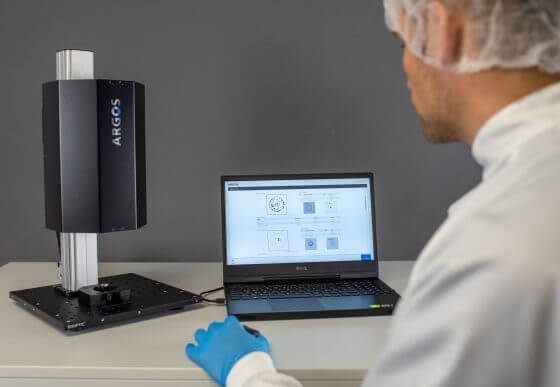
Micro-optics
Micro-optics with diameters starting from about 1 mm can be tested very efficiently with our
↓ ARGOS matrix system. Surfaces are recorded in one shot, which allows a very fast inspection. The ARGOS matrix system is modular. Several image field options and different illuminations are available, which allow an exact adaptation to your measurement and automation requirements. Especially for the inspection of micro-optics, highest resolutions can be achieved and, if required, defects smaller than 1 µm in size can still be reliably detected.
Since the handling of individual components is much more difficult for micro-optics, the ARGOS matrix system was intentionally designed so that components in different carriers or holders can be tested. For example, it is possible to insert assembled coating holders into the device in order to check all optics before and after coating.
Assembly of optical components
In manufacturing processes where for example filters or protective glasses are hermetically bonded to another optical component, it is very important to avoid trapped particles. With an
↓ ARGOS matrix system this can be guaranteed in a fast and safe way directly at the assembly station with only a few measurements. Both sides of the filter/protective glass as well as the surface to be sealed, e.g. a sensor, are scanned with ARGOS matrix, cleaned if necessary, then mounted and finally a further measurement proves that no particles are trapped.
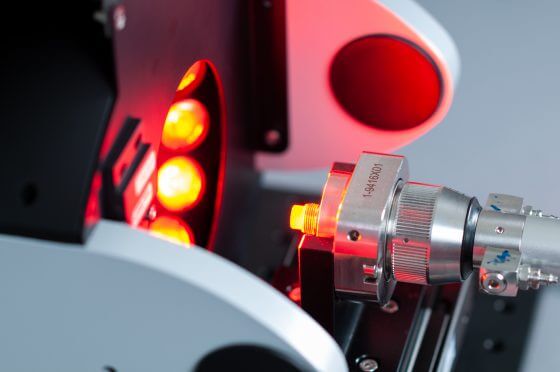
Fiber end surfaces
High quality standards of cleanliness apply to the end surfaces of optical cables, as used in systems for laser cutting and welding of metals. Due to the high laser power, even the smallest contamination can cause damage to coatings and components.
Our solution ↓ ARGOS fiber cable for the inspection of fiber end surfaces also allows the inspection of solid, water-cooled fibers with standardized connectors (e.g. QBH). The geometry of the ARGOS system has been adjusted for easy handling. End faces with a diameter of up to 22 mm can be inspected in a few seconds. Even defects and particles with a size of 1 µm are reliably detected. Also typical defects like pits and burn marks can be accurately identified with ARGOS.
The ARGOS family
The variety of optical components is immense. As diverse as optical components can be, so are the requirements for surface inspection:
From the smallest micro-optics for endoscopes or mobile phones, to demanding optics for high-power lasers or astronomical applications, to the inspection of wafers or wafer-level optics.
In order to meet this broad range, we have developed the ARGOS family:
- ARGOS matrix is particularly efficient for small optics with diameters up to about 15 mm, but also inspects larger components either individually in a stitching process or in a cassette fully automatically together with other test objects. In addition, ARGOS matrix inspects entire production batches automatically in series.
- ARGOS 2.1 inspects plane and rotationally symmetric optics with diameters of about 5 to 55 millimeters.
- ARGOS 200 extends the measuring range in the direction of larger diameters up to 200 mm and is particularly suitable for high-resolution inspection of wafers for particle and defect distributions.
A general overview about the capabilities of the ARGOS family members can be found here:
↓ ARGOS matrix – Universal device and fully automated optical inspection
↓ ARGOS matrix with XY-Scan – The optimized adapted serial inspection
↓ ARGOS 2.1 – The special unit for rotationally symmetric optics
↓ ARGOS 200 – Maximum resolution (not only) for large optics
↓ ARGOS fiber cable – Testing of fiber end surfaces
↓ ARGOS linear – The solution for cylindrical lenses and non-rotationally symmetric optics

ARGOS matrix – Universal device and fully automated optical inspection
The latest member of the ARGOS family offers a completely new developed measuring head, which provides the perfect conditions for high-resolution inspection of smaller optics up to 15 mm diameter. Larger optics up to 25 mm can also be inspected with a single measurement if the surface quality requirements are somewhat lower.
The very compact system offers manual or fully automated optics inspection, depending on the configuration level. ARGOS matrix is available in 3 standard configurations for different inspection diameters and resolutions (🗎 ARGOS matrix product sheet ).
You have an inspection task where larger elements have to be inspected, but smallest defects below 10 µm are irrelevant? Thanks to the modular design of the ARGOS matrix system, we can offer you a solution perfectly adapted to your requirements.
Furthermore, the ARGOS matrix measuring head can also be very well integrated into larger installations or measuring systems. The ARGOS software can be easily remote controlled via our Web API. So nothing prevents a complete integration into your automated system.
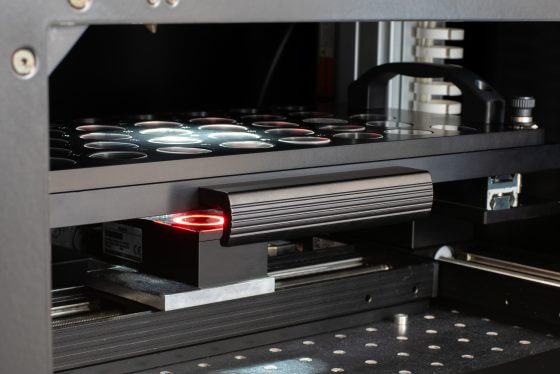
ARGOS matrix with XY-Scan – The optimized adapted serial inspection
With the XY-Scan module, ARGOS matrix enables the automated surface inspection of dozens or, depending on the size, hundreds of elements without user interaction. The individual components are placed on cassettes with numbered cavities and inspected one after the other. A detailed inspection report is generated for each optical component. A summary report also gives a review of the most important results, especially pass/fail for each individual element.
By combining several illumination techniques, even hardly visible and small defects (down to 1 µm) are reliably detected. To detect holes and defects in chrome masks, for example, the system can be equipped with a transmitted light module. We adapt the modular system individually to your needs. Are you interested in serial inspection of a few different optics? We can optimize the test duration by precisely adapting the resolution of the system to your requirements.
You can read more about automated serial inspection with ARGOS matrix in our 🗎 ARGOS matrix product sheet.

ARGOS 2.1 – The special unit for rotationally symmetric optics
Our standard device ARGOS 2.1 for optics with up to 55 mm diameter guarantees reliable detection of defects and contamination. Inspection is possible up to 5/1×0.025 according to the regulations of ISO 10110-7. This makes the device suitable even for demanding high power laser applications. Curved surfaces and volumes for detection of air bubbles or inclusions can be inspected with automatic focus stacking. A combined inspection of surfaces and volumes in one scan is also possible.
The larger the optics, the more efficient the inspection, as a scan of the 55 mm diameter surface is performed in two seconds. The data processing of the 250 megapixel images is also highly optimized, so it takes only a few seconds to obtain the result.
ARGOS 2.1 is the consistent enhancement of our successful ARGOS 2 device. Many years of experience in the market and valuable feedback from our customers have gone into the design of the device and the software. The maximum test diameter was increased from 45 mm to 55 mm. In addition, now even lenses with higher curvature can be tested. This makes the instrument more universal than ever before and allows testing of an even wider range of optical components (🗎 ARGOS 2.1 spec sheet.

ARGOS 200 – Maximum resolution (not only) for large optics
ARGOS 200 is the right choice for all customers who also need to inspect large optics or wafers up to 200 mm/8″ diameter (🗎 ARGOS product sheet). It enables the inspection of large areas in highest resolution and is still fully optimized for speed. ARGOS 200 inspects a 200 mm wafer in a few minutes. The entire surface is scanned fully automatically.
On request, with an additional sensor, ARGOS 200 can measure the surface and fully parameterize the inspection automatically. This is particularly useful for the inspection of thin wafers that are easily warped by coatings. ARGOS automatically compensates this and also determines the actual shape of the wafer and the extent of the distortion.
Furthermore, ARGOS 200 can also inspect entire production batches of small flat optics on a 200 mm diameter carrier at once. You will receive inspection reports per component as well as a collective report with all results.
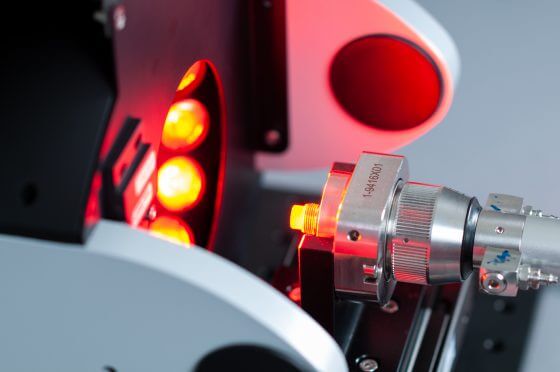
ARGOS fiber cable – Testing of fiber end surfaces
Using ARGOS fiber cable, fiber end surfaces are inspected quickly and reliably. The high-resolution scanning of the end surfaces of fiber optic cables with standardized connectors (e.g. QBH) allows the detection of contamination and defects down to 1 µm. The measuring head is identical to our high-resolution model ARGOS 200, so that even smallest particles and burns are detected properly.

ARGOS linear – The solution for cylindrical lenses
and non-rotationally symmetric optics
The scanning systems ARGOS 2.1 and ARGOS 200 are best equipped to inspect flat parts and rotationally symmetric, spherical and aspherical lenses. Non-rotationally symmetric parts, such as cylindrical lenses, require a different inspection geometry. With ARGOS linear the part is scanned linear and not rotated as in the standard systems. This makes the system perfectly suited to inspect cylindrical lenses up to 22 mm width. It is also possible to inspect several cylindrical lenses in a single pass.
More information about ARGOS
Presentation ARGOS2 one-click surface inspection
Sales Team | Tel.: +49 6201 960 90 – 20